B.R. Bates's Blog: From the social feeds ..., page 5
May 19, 2025
Watch my new interview on the Cameron Journal

What was the difference between what the world knew about Benjamin ("Tony") Atkins at the time of his #serialkiller case back in 1992, and the research that went into the book "The Crack City Strangler"? And what's the process for putting together the facts in a project like this? And how about the mysterious case of the missing files??? I talk with Cameron Cowan of the Cameron Journal #podcast about that and more in an episode that just dropped today! Check it on #Apple, #Spotify, #Podchaser, #AmazonMusic and other locales.
Thanks, Cameron! Watching it right now as I'm posting.
Listen to my new interview on the Cameron Journal

What was the difference between what the world knew about Benjamin ("Tony") Atkins at the time of his #serialkiller case back in 1992, and the research that went into the book "The Crack City Strangler"? And what's the process for putting together the facts in a project like this? And how about the mysterious case of the missing files??? I talk with Cameron Cowan of the Cameron Journal #podcast about that and more in an episode that just dropped today! Check it on #Apple, #Spotify, #Podchaser, #AmazonMusic and other locales.
Thanks, Cameron! Listening right now as I'm posting.
May 16, 2025
#RememberThem: Natasha, survivor
Natasha is not really a "victim." At least I prefer not to think of her that way, though she has felt like a victim so much over the years. She is a survivor, and I keep telling her that. The Lord has spared her for a reason.
She has seen her kids grow up, since that night she survived convicted serial killer John Eric Armstrong in August 1999. She has seen her grandchildren born. She has been a special person in their lives, and in my life, too. She has impacted people with her story. She was spared for a reason. Or multiple reasons.
As I have blogged before, many times women are living at risk out on the streets, doing sex work, to feed a drug habit. Natasha is the exception. She didn't do any drugs. She will tell you to this day that she was just out there to get some cash. She lived in Grand Rapids, on the west side of Michigan, and she would travel to Detroit for a stretch of days, stay in a motel, make some money, then head back to Grand Rapids. She was about to head back, that day in August 1999, but she decided to stay one more night then leave the next day. But what happened on that night changed her life forever.
He picked her up on Michigan Ave. They went back to her motel room. He seemed nervous. Antsy. He used the bathroom. Said he had to leave. But then a minute later, there's a knock on her door. Him again. She will always regret letting him back in. They tussled all over the room, he armed with a knife that he tended to use to threaten and weaken his victims, though his M.O. was always strangulation. There are more details to the story, but where it ended up was with Natasha playing dead, the cord from the room phone round around her neck, and him leaving.
Next, Natasha had to face the fact that cops don't always take seriously an assault on a prostitute. She reported the crime, police responded, did a little looking around. The clues were there, in the room. They were not really investigated. Had they been, it's possible the other nine people Armstrong went on to assault in Detroit would have been spared. That's one sad aspect of many surrounding Natasha's attack.
But ... spared for a purpose. Let's get back to that aspect. Because I choose to believe that it's far more important.
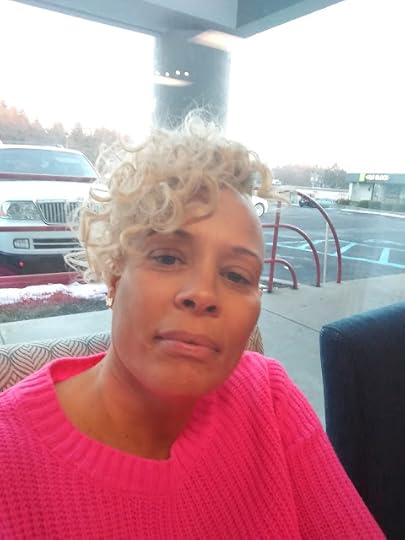 Natasha these days.
Natasha these days.Image courtesy of Natasha; see note below.
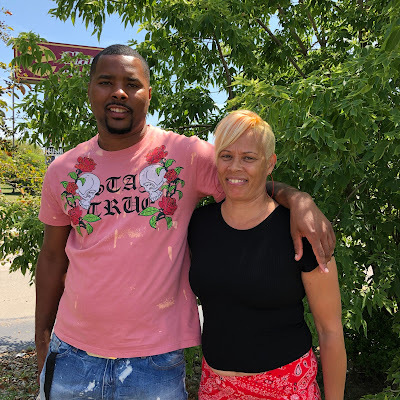 Natasha with her son Kenny, above, and below, her son Ronnie and his own son.
Natasha with her son Kenny, above, and below, her son Ronnie and his own son.Above image by the author and below image courtesy of Natasha; see note below.
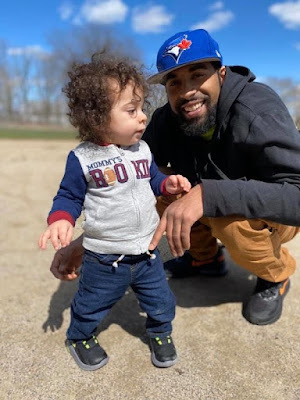
This post is part of a series on this blog that I am calling #RememberThem, a chance to honor the women who lost their lives to the two Detroit serial killers I have researched, John Eric Armstrong and Benjamin ("Tony") Atkins. In this continuing series, with installments dropping every week or so, we'll first learn more about the five women Armstrong was known to have killed in Detroit, then two of his survivors, then we'll turn to the women killed by Atkins. Click on the "Honoring the Victims" label on the left to see all of the parts in the series.
. . . . . . . . . . . . . . . . . . . . . . . . . .
 BRBates.comwbp.bz/BabyDoll
BRBates.comwbp.bz/BabyDollAbove photos are copyrighted and specifically for use in "The 'Baby Doll' Serial Killer"; any other use prohibited without permission.
See more photos from the case at the gallery on the WildBlue Press website.
May 13, 2025
Helping 1,891 young people in 2024 -- now that's impact
Covenant House Michigan has been doing great work at its Detroit location for many years, and more recently it opened a location on the other side of the state, in Grand Rapids, for even more impact. Covenant House is an international nonprofit organization dedicated to empowering young people to overcome homelessness and trafficking by providing best-in-class services and a shared commitment to unconditional love, absolute respect, and relentless support for each young person who walks through their doors. I first discovered them through the "Please Forgive Me, God" book when I was living in D.C., and I've been supporting them ever since, turning my focus to the Detroit location when I moved back to my home state of Michigan in 2013. I hope you'll consider supporting them in your own giving, as well, because I can vouch for this organization. I've toured the Detroit campus and seen close-up exactly what they do for the youth of the Motor City area. They save lives, and it strikes close to my heart as I research the criminal cases that have occurred in Detroit over the years. Some of the victims of the two serial killers I've studied were in the same boat as the youth Covenant House scoops off the street -- runaways, maybe drug-addicted, desperately needing help. I know that because of their work, fewer young people have been on the street, at risk for predators like the ones I've written about.
This flyer shows their impact just last year. Nights of housing provided for youth: 29,514! Youth served through their street outreach programs: 1,269! Download this image and share to raise awareness and support for this valuable ministry.
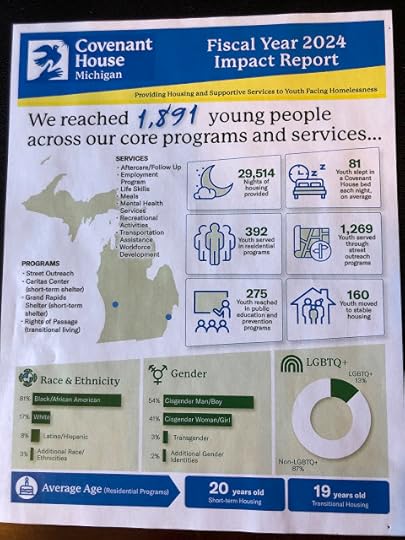
May 9, 2025
#RememberThem: Nicole
Nicole came to Detroit from Chicago, evidently with her boyfriend, whom some have called her pimp. She wasn’t on the streets of the Motor City for very long before she encountered John Eric Armstrong.
She would be the last person he was known to kill, and investigators really had a time figuring out which was her real name — Nicole or Robin — and what was her true age. She had arrest records and would tell police different things at different times.
After her death and with some digging, police learned she was younger than they thought — just 17. She had been aging herself up a bit so that police would not return her to her family, a family that by some accounts didn't want her. There was no one who would come to claim her body in Detroit. The prosecutor, Betty Walker, was able to contact the family at one point, requesting a photo of Nicole that could be used at trial. What they sent was an early grade school photo.
As I researched the Armstrong case for "The ‘Baby Doll’ Serial Killer: The John Eric Armstrong Homicides," I was determined to reach at least one person to speak for each of the five women who lost their lives in Detroit. Nicole was the most difficult of the five -- no one seemed to know her or want to claim her. I almost was able to reach her boyfriend, on a tip from the landlady of the building where she had sometimes been in Chicago for a brief time. It was a couple degrees of separation at best. But the boyfriend wouldn't respond, so I had to take what the landlady said, and she really didn't know her.
Soooo ... 17 years, reduced to a few paragraphs, unfortunately. There was someone who commented on a podcast on the case on YouTube, saying they knew her, she loved to dance, and had a great smile. I was pretty thankful to read something like that.
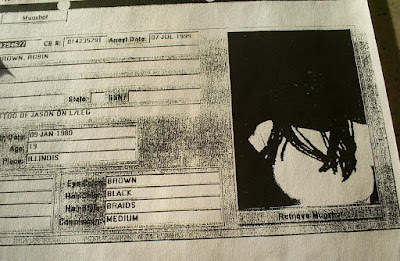 Above and below: A couple of Nicole's arrest records. She also went by the name Robin / Robbin.
Above and below: A couple of Nicole's arrest records. She also went by the name Robin / Robbin.Images from Detroit Police files.
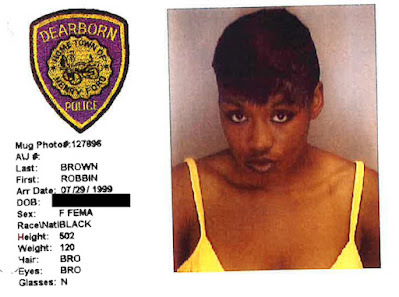
 The building in Chicago where Nicole stayed for a time before coming to Detroit.
The building in Chicago where Nicole stayed for a time before coming to Detroit.Image by Google.
This post is part of a series on this blog that I am calling #RememberThem, a chance to honor the women who lost their lives to the two Detroit serial killers I have researched, John Eric Armstrong and Benjamin ("Tony") Atkins. In this continuing series, with installments dropping every week or so, we'll first learn more about the five women Armstrong was known to have killed in Detroit, then two of his survivors, then we'll turn to the women killed by Atkins. Click on the "Honoring the Victims" label on the left to see all of the parts in the series.
. . . . . . . . . . . . . . . . . . . . . . . . . .
 BRBates.comwbp.bz/BabyDoll
BRBates.comwbp.bz/BabyDollAbove photos are copyrighted and specifically for use in "The 'Baby Doll' Serial Killer"; any other use prohibited without permission.
See more photos from the case at the gallery on the WildBlue Press website.
May 5, 2025
Hearing voices and more: Mysteries, Mayhem & Merlot explores "The Crack City Strangler"
Podcaster Winnie Schrader of "Mysteries, Mayhem & Merlot" had not really heard of Benjamin ("Tony") Atkins before, and yeah, I believe it. He's not a widely known serial killer. In the latest episode of Winnie's true-crime podcast, we dive into this case, including Atkins' troubled childhood and what could have possibly led to his several months of murder on Woodward Ave in Detroit, when 11 women lost their lives.
May 2, 2025
#RememberThem: Kelly
Kelly loved animals of all kinds, her son Kyle told me. He joked that they had all kinds of animals -- even barnyard animals -- around their house when he was a kid. And here they were living in the inner city of Detroit (!), where Kelly had met and married Kyle's dad years earlier.
Kelly had a legit life, off and on. People don't figure women living at risk on the street, doing sex work to feed a drug habit, ever had a legit life. But they tend to come from families that are what we consider traditional -- a mom, a dad, siblings, a stable home. But a wrong turn here or there throws them off course. So often, it is addiction. That's what puts them out there on the street, and it was in Kelly's case.
The truly heartbreaking thing about Kelly's case was that just before she was killed by John Eric Armstrong in April 2000, she had been in the hospital, and when she was released, her sister pleaded with her to come home, to the west side of Michigan where she was originally from, to let her family take care of her for a while. She made excuses but when it came down to it, she wouldn't do it. Right after that, Armstrong picked her up on Michigan Ave.
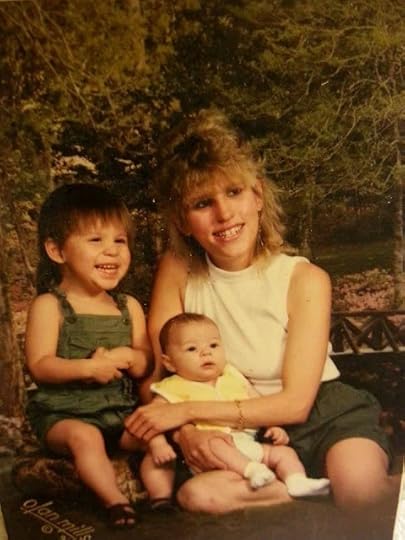 Kelly with Kyle, left, and one of his siblings.
Kelly with Kyle, left, and one of his siblings.Image courtesy of Kyle; see note below.
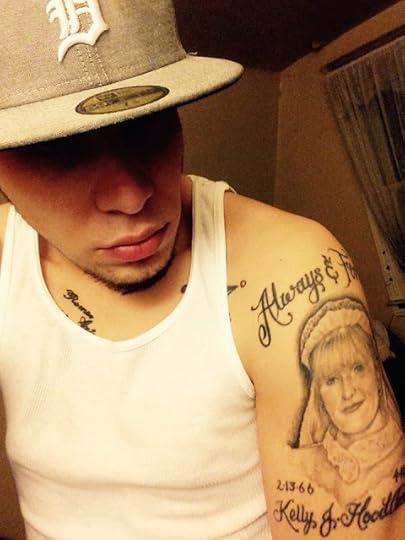 Kyle pays tribute to his mom with a tattoo by Chico of Tattoo Addicts of Allen Park, Michigan. Kyle has added to it a bit over the years.
Kyle pays tribute to his mom with a tattoo by Chico of Tattoo Addicts of Allen Park, Michigan. Kyle has added to it a bit over the years.Images courtesy of Kyle; see note below.
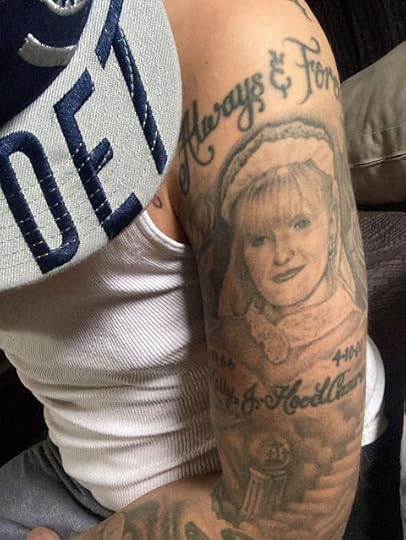
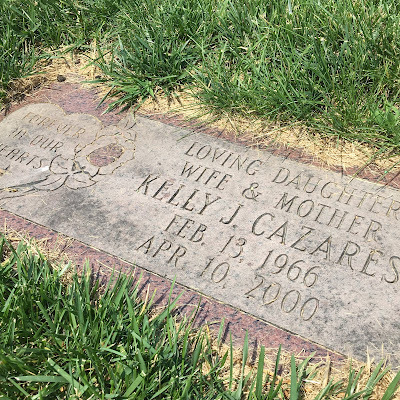 Image by the author; see note below.
Image by the author; see note below.This post is part of a series on this blog that I am calling #RememberThem, a chance to honor the women who lost their lives to the two Detroit serial killers I have researched, John Eric Armstrong and Benjamin ("Tony") Atkins. In this continuing series, with installments dropping every week or so, we'll first learn more about the five women Armstrong was known to have killed in Detroit, then two of his survivors, then we'll turn to the women killed by Atkins. Click on the "Honoring the Victims" label on the left to see all of the parts in the series.
. . . . . . . . . . . . . . . . . . . . . . . . . .
 BRBates.comwbp.bz/BabyDoll
BRBates.comwbp.bz/BabyDollAbove photos are copyrighted and specifically for use in "The 'Baby Doll' Serial Killer"; any other use prohibited without permission.
See more photos from the case at the gallery on the WildBlue Press website.
#RememberThem: Kelly Jean Hood
Kelly loved animals of all kinds, her son Kyle told me. He joked that they had all kinds of animals -- even barnyard animals -- around their house when he was a kid. And here they were living in the inner city of Detroit (!), where Kelly had met and married Kyle's dad years earlier.
Kelly had a legit life, off and on. People don't figure women living at risk on the street, doing sex work to feed a drug habit, ever had a legit life. But they tend to come from families that are what we consider traditional -- a mom, a dad, siblings, a stable home. But a wrong turn here or there throws them off course. So often, it is addiction. That's what puts them out there on the street, and it was in Kelly's case.
The truly heartbreaking thing about Kelly's case was that just before she was killed by John Eric Armstrong in April 2000, she had been in the hospital, and when she was released, her sister pleaded with her to come home, to the west side of Michigan where she was originally from, to let her family take care of her for a while. She made excuses but when it came down to it, she wouldn't do it. Right after that, Armstrong picked her up on Michigan Ave.
 Kelly with Kyle, left, and one of his siblings.
Kelly with Kyle, left, and one of his siblings.Image courtesy of Kyle; see note below.
 Kyle pays tribute to his mom with a tattoo by Chico of Tattoo Addicts of Allen Park, Michigan. Kyle has added to it a bit over the years.
Kyle pays tribute to his mom with a tattoo by Chico of Tattoo Addicts of Allen Park, Michigan. Kyle has added to it a bit over the years.Images courtesy of Kyle; see note below.

 Image by the author; see note below.
Image by the author; see note below.This post is part of a series on this blog that I am calling #RememberThem, a chance to honor the women who lost their lives to the two Detroit serial killers I have researched, John Eric Armstrong and Benjamin ("Tony") Atkins. In this continuing series, with installments dropping every week or so, we'll first learn more about the five women Armstrong was known to have killed in Detroit, then two of his survivors, then we'll turn to the women killed by Atkins. Click on the "Honoring the Victims" label on the left to see all of the parts in the series.
. . . . . . . . . . . . . . . . . . . . . . . . . .
 BRBates.comwbp.bz/BabyDoll
BRBates.comwbp.bz/BabyDollAbove photos are copyrighted and specifically for use in "The 'Baby Doll' Serial Killer"; any other use prohibited without permission.
See more photos from the case at the gallery on the WildBlue Press website.
April 30, 2025
Talking "Crack City Strangler" on the Crawlspace podcast
Listening to this right now ... My interview with Tim and Lance of the Crawlspace podcast has just dropped. What is it about the city of Detroit that gives such good content for books like "The Crack City Strangler," about convicted serial killer Benjamin Atkins? And why the interest in those who hunt women at risk on the street? We talk about that and more. You can check it out on YouTube below, and also on Apple and Spotify. Thanks again, guys!
🔗
.............................
April 28, 2025
Join Covenant House Michigan for 'A Night of Detroit Stars' next month
This author can tell you, the stars really shine bright in Detroit. You can get your tickets right now to see some of those stars and benefit the great work of Covenant House Michigan at the same time. Join them for "A Night of Detroit Stars" on May 21, an uplifting evening of music, song, and theatrics supporting their mission to end youth homelessness. The evening will feature a cast of accomplished Detroit performers, as well as the true stars – the organization's youth residents. It all happens inside the Sound Board Theater at the MotorCity Casino Hotel.
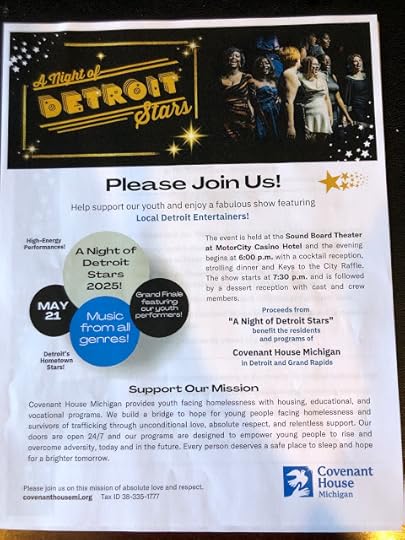
Download this flyer image and share widely!
I have supported the Detroit location of Covenant House Michigan for many years, and I hope you'll consider it in your own giving, as well.
From the social feeds ...
- B.R. Bates's profile
- 8 followers



